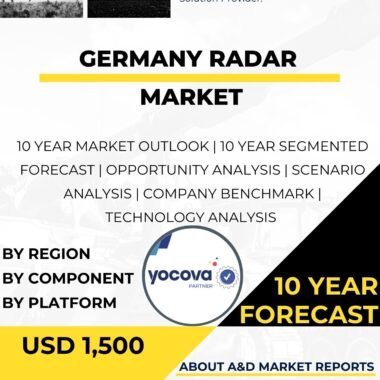Description
Malaysia Surveillance Radar market has witnessed significant growth and development in recent years, reflecting the country’s strong commitment to enhancing its defense capabilities, airspace surveillance, and border security. Surveillance radars, which are advanced electronic systems designed to detect, track, and monitor aerial and maritime activities, form a critical component of Malaysia’s modern defense infrastructure. The integration of advanced radar technologies enables Malaysia to build a robust, networked surveillance ecosystem that supports national security and operational readiness.
Strategic Importance of the Surveillance Radar Market in Malaysia
Malaysia’s strategic geopolitical position in Southeast Asia exposes the nation to various security challenges, including territorial disputes, transnational crime, illegal border crossings, and maritime incursions. In this environment, surveillance radars serve as essential tools for monitoring airspace, territorial waters, and land borders, allowing security forces to detect potential threats and respond in a timely manner. These capabilities ensure that Malaysia can safeguard its sovereignty and maintain stability in a region marked by evolving security dynamics.
Technological Advancements in the Surveillance Radar Market in Malaysia
The Surveillance Radar market in Malaysia has experienced rapid technological progress with the introduction of advanced signal processing algorithms, high-resolution sensors, and data fusion systems. These improvements provide extended detection ranges, greater precision, and enhanced real-time intelligence. Modern radar technologies offer superior performance in various weather conditions and can detect diverse targets, including low-flying aircraft, small maritime vessels, and unmanned systems. Such advancements significantly strengthen Malaysia’s surveillance and early warning capabilities.
Defense Applications in the Surveillance Radar Market in Malaysia
Surveillance radars are central to the operational framework of the Royal Malaysian Air Force (RMAF) as well as multiple civilian and maritime agencies. The RMAF employs these systems for airspace management, air defense, and early warning missions, ensuring that potential aerial threats are identified and addressed promptly. Beyond air defense, agencies like the Malaysian Maritime Enforcement Agency rely on surveillance radars to monitor maritime activities, detect illegal fishing, identify suspicious vessels, and support search and rescue operations. These multifaceted applications underscore the importance of radar systems in comprehensive national security operations.
Industrial Development in the Surveillance Radar Market in Malaysia
The growth of the Surveillance Radar market aligns with Malaysia’s broader goal of strengthening its defense industrial base and fostering indigenous technological capabilities. Government-led research and development initiatives, along with partnerships involving global radar manufacturers, contribute to local production, technology transfer, and industrial expansion. By developing domestic expertise in radar technology, Malaysia aims to reduce dependence on foreign suppliers and enhance long-term self-reliance in defense technology.
International Collaboration
Recognizing the importance of global cooperation, Malaysia has pursued international partnerships to acquire, develop, and upgrade its surveillance radar capabilities. Collaborations with global defense contractors and radar system providers have enabled access to the latest radar technologies and operational expertise. These partnerships support technology transfer, training programs, system integration, and continuous enhancement of Malaysia’s radar infrastructure, bolstering the nation’s defense posture.
Challenges Facing the Market
Despite promising growth, the Surveillance Radar market in Malaysia faces several challenges. Advanced radar systems require substantial financial investment for acquisition, maintenance, training, and lifecycle support. Budgetary constraints may influence the pace of modernization and expansion. Additionally, the operation of sophisticated radars demands highly skilled personnel, making continuous training and education essential. Another challenge lies in ensuring consistent radar coverage across Malaysia’s diverse geographical regions, requiring the integration of long-range, medium-range, and short-range radar systems into a seamless surveillance network.
Future Outlook
The future of the Surveillance Radar market in Malaysia appears promising, driven by the government’s ongoing commitment to strengthening defense, enhancing airspace monitoring, and adopting advanced technologies. As radar systems continue to evolve with improved detection capabilities and data integration features, they are expected to play a more central role in Malaysia’s national security strategy. Furthermore, Malaysia’s participation in joint security initiatives and regional defense collaborations will shape the development of interoperable radar systems capable of operating alongside allied forces.
Conclusion
In conclusion, the Surveillance Radar market in Malaysia has undergone remarkable growth, fueled by strategic modernization efforts, technological innovation, and international collaboration. The integration of advanced radar systems enhances Malaysia’s airspace surveillance, maritime security, and overall defense preparedness. However, addressing challenges related to funding, technological development, personnel training, and coverage integration will be essential to sustain progress. By maintaining a modern and well-integrated radar infrastructure, Malaysia is well-positioned to safeguard its territorial integrity, strengthen its defense capabilities, and adapt to the evolving security landscape.




